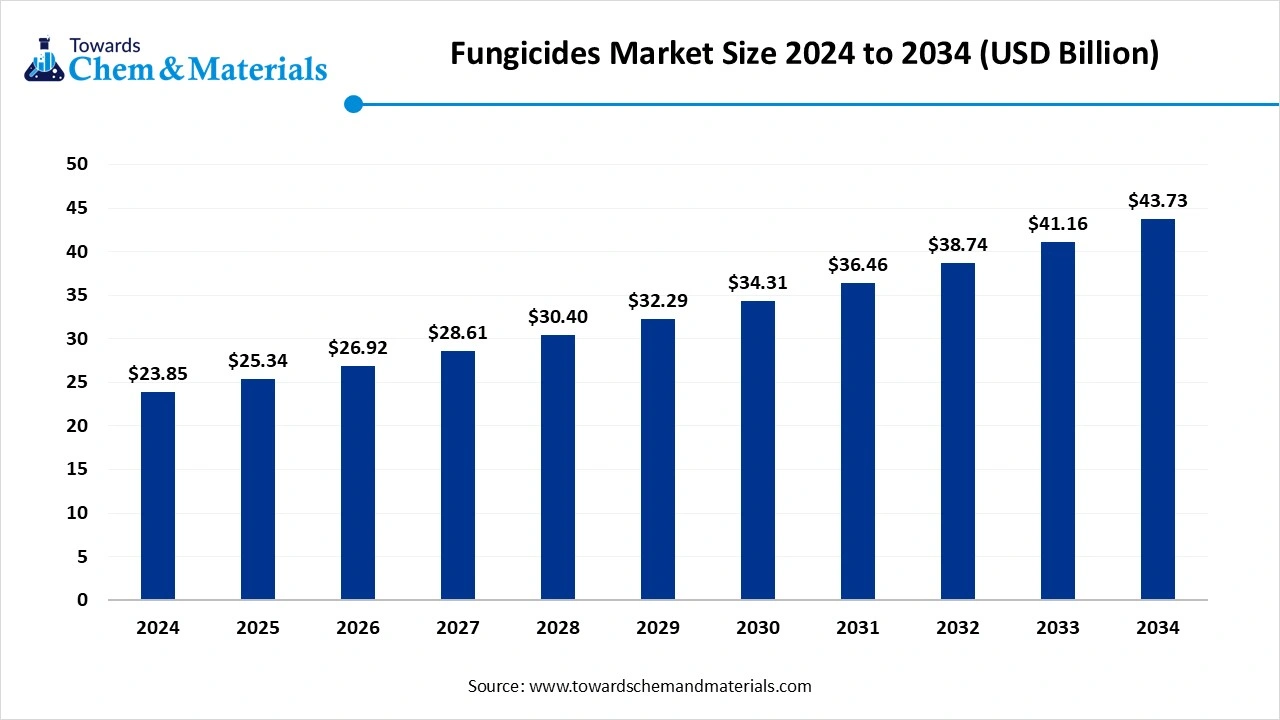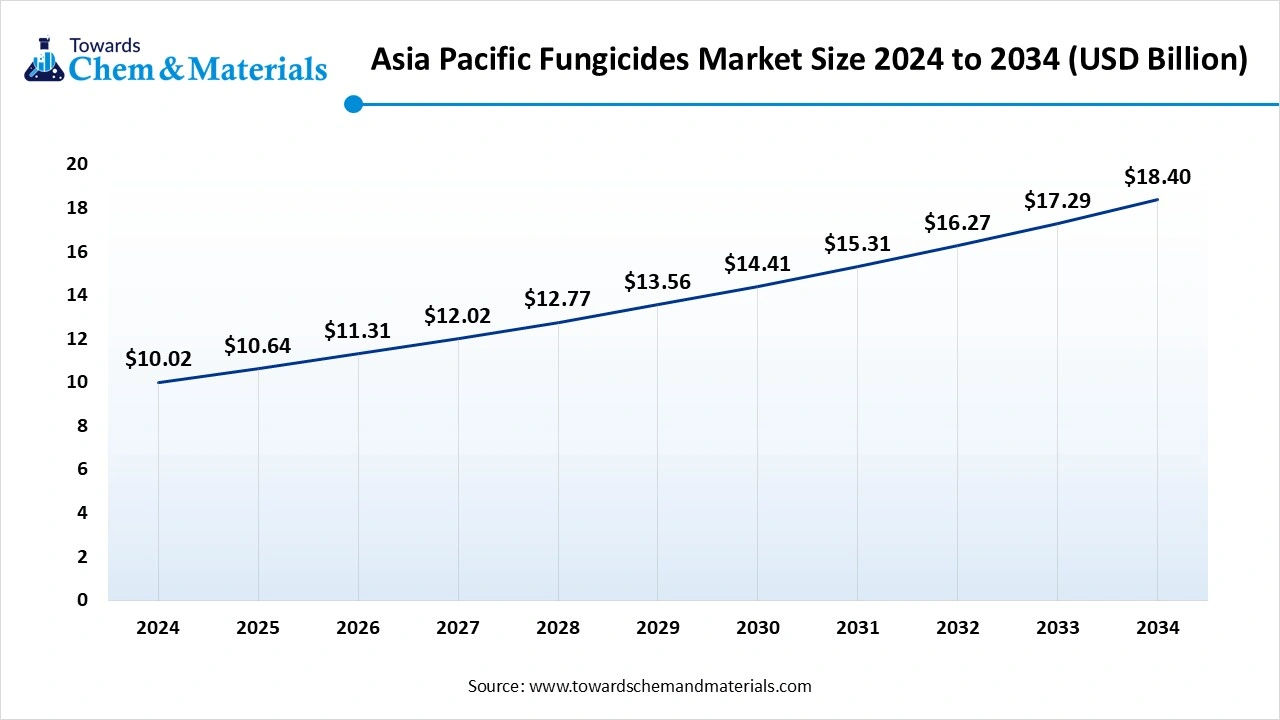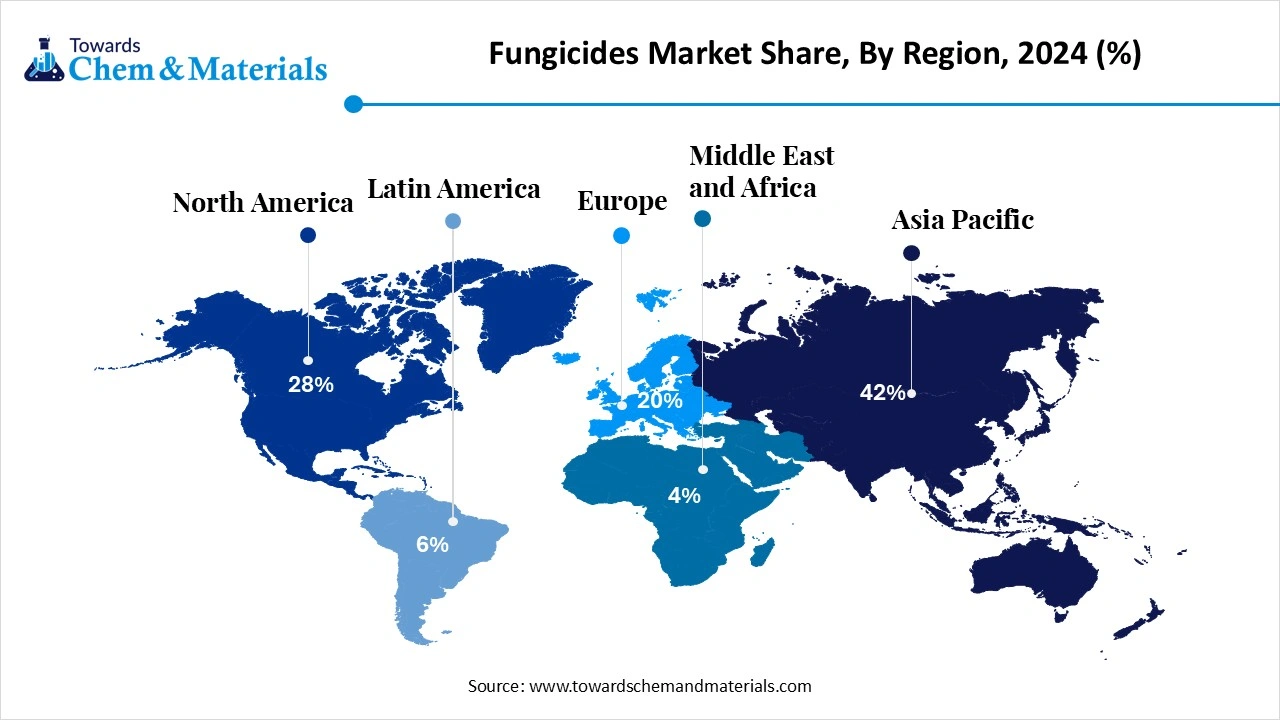December 2025
The global fungicides market size was reached at USD 25.34 billion in 2024 and is expected to be worth around USD 43.73 billion by 2034, growing at a compound annual growth rate (CAGR) of 6.25% over the forecast period 2025 to 2034.The ongoing innovations in fungicide formulations and application technologies are the key factors driving market growth. Also, a surge in consumer demand for healthy fruits and vegetables, coupled with the increase in the number and severity of fungal infections in crops, can fuel market growth further.

Rising disease incidence due to changing climatic conditions, expansion of high-value crops, and growing regulatory support for biocontrol products are driving steady market growth. The Global Fungicides Market encompasses chemical and biological products formulated to prevent or control fungal diseases in crops, turf, ornamentals, and seeds. Fungicides protect yield and crop quality by inhibiting spore germination or fungal growth through contact, translaminar, or systemic action.
The market includes conventional synthetic fungicides (triazoles, strobilurins, carbamates, dithiocarbamates, and others) as well as biological and natural-origin products gaining traction with sustainable agriculture. Integration with precision spraying, seed treatment, and digital crop monitoring solutions is reshaping the sector.
| Report Attributes | Details |
| Market Size in 2026 | USD 26.92 Billion |
| Expected Size by 2034 | USD 43.73 Billion |
| Growth Rate from 2025 to 2034 | CAGR 6.25% |
| Base Year of Estimation | 2024 |
| Forecast Period | 2025 - 2034 |
| Dominant Region | Asia Pacific |
| Segment Covered | By Type / Chemical Class, By Mode of Action, By Formulation Type, By End Use, By Distribution Channel, By Region |
| Key Companies Profiled | Syngenta AG (ChemChina Group), Corteva Agriscience, FMC Corporation, UPL Limited, Nufarm Limited, Sumitomo Chemical Co., Ltd., Adama Agricultural Solutions Ltd., Isagro S.p.A. (Gowan Group), Marrone Bio Innovations (Biologicals by Bioceres), Certis Biologicals, Nippon Soda Co., Ltd., Rotam CropSciences Ltd., Indofil Industries Ltd. |
Key technological shifts in the market are propelled by the growing demand for precision applications, sustainable agriculture, and cutting-edge new product chemistry. Advancements focus on creating more effective, targeted, and sustainable solutions to address the surge in pathogen resistance, which is impacting market expansion in the near future.
| Country/Region | Key Regulations |
| European Union | The European Commission revised MRLs for several pesticides in 2024, including benzovindiflupyr, chlorantraniliprole, emamectin, and quinclorac. |
| United States | Following a federal court order, the EPA issued cancellation orders for most chlorpyrifos products in 2024, citing neurodevelopmental risks in children. |
| China | In December 2023, China banned the production and use of four highly toxic pesticides, including carbofuran and methomyl. A sell-and-use grace period was extended until December 2025. |
Which Chemical Class Type Segment Dominated the Global Fungicides Market in 2024?
The triazoles segment dominated the market with a 32% share in 2024. The dominance of the segment can be attributed to the growing demand for high-yield crops, because of the surge in global population and the sudden increase in fungal diseases across the globe caused by climate change. Additionally, triazoles are known for their broad-spectrum effectiveness against numerous fungal diseases, which makes them a key tool for farmers.
The biological & bio-based fungicides segment is expected to grow at the fastest CAGR of 24% over the forecast period. The growth of the segment can be credited to the growing consumer demand for organic food, along with the innovations in agricultural technology. Biofungicides are used widely on high-grade specialty crops, such as fruits and vegetables, to meet consumer demand for clean-label produce.
How Much Share Did the Systemic Segment Held in 2024?
The systemic segment held a 45% market share in 2024. The dominance of the segment can be linked to the growing global food demand and surge in crop disease prevalence, which requires effective crop protection and higher crop yields. In addition, advancements in fungicide formulation and delivery techniques are enhancing the effectiveness and efficiency of systemic formulations.
The mixed-mode segment is expected to grow at the fastest CAGR of 20% over the forecast period. The growth of the segment can be driven by the growing demand for high-efficiency and sustainable crop protection methods, coupled with the increase in global food demand. Moreover, major players such as Syngenta and BASF are rapidly investing in research and development to launch new combinations of ingredients.
Which Formulation Type Segment Dominated the Global Fungicides Market in 2024?
The suspension concentrates (SC) segment dominated the market by holding a 33% share in 2024. The dominance of the segment is owed to the growing global demand for water-based, high-performance formulations, which are safer and more efficient than traditional options. Furthermore, these formulations are compatible with precision agriculture, such as Unmanned Aerial Systems (UAS).
The water-dispersible granules (WG) segment is expected to grow at the fastest CAGR of 21% during the projected period. The growth of the segment is due to its sophisticated safety, handling, and performance benefits for farmers and major players. WG fungicides are much drier, dust-free, and can disperse rapidly in water, which makes them a superior alternative to other powder and liquid formulations.
How Much Share Did the Commercial Farmers Segment Held in 2024?
The commercial farmers segment held a 70% market share in 2024. The dominance of the segment can be attributed to the rapidly changing agricultural trends and ongoing demand to maximize yields. Advancements in precision agriculture, such as smart spraying systems, allow commercial farmers to apply fungicides more efficiently and strategically, leading to segment growth soon.
The horticultural grower segment is expected to grow at the fastest CAGR of 20% during the forecast period. The growth of the segment can be credited to the rise in fungal disease incidence due to climate change and the growing demand for high-value crops globally. Also, the cultivation of high-value horticultural crops, such as vegetables, specialty fruits, and ornamentals, is expanding across the globe.
Which Distribution Channel Segment Dominated the Global Fungicides Market in 2024?
The agrodealers / distributors segment dominated the market by holding a 58% share in 2024. The dominance of the segment can be linked to the surge in consumer health concerns and interest in sustainable and organic farming. Additionally, agrodealers build brand and trust loyalty by providing technical expertise and educational workshops, which ensures farmers depend on them for their product needs.
The E-commerce / digital Ag platforms segment is expected to grow at the fastest CAGR of 25% over the forecast period. The growth of the segment can be driven by the rise of precision agriculture and the surge in penetration of the internet and smartphones. These platforms further offer farmers a wide market access with data-driven insights and enhanced supply chain management.
Asia Pacific dominated the market with a 42% share in 2024.
The Asia Pacific fungicides market size is valued at USD 10.64 billion in 2025 and is expected to surpass around USD 18.40 billion by 2034, expanding at a compound annual growth rate (CAGR) of 6.27% over the forecast period from 2025 to 2034.

The dominance of the segment can be attributed to the increasing demand for food security for a growing population, along with the government's support for agriculture. In addition, the region's large population needs more food, which in turn fuels the demand for higher crop yields.
China Global Fungicides Market Trends
In the Asia Pacific region, China dominated the market owing to the ongoing innovations in agricultural technology and the rapid shift towards more sustainable practices. China is also a major exporter of agricultural products, which meet the international market's strict quality standards by maximizing residue levels.
Latin America is expected to grow at the fastest CAGR of 22% over the forecast period. The growth of the region can be credited to the increase in adoption of modern farming practices and the favorable climate for fungal diseases. The region is also a world leader in producing and trading high-demand crops such as corn, sugar, coffee, and soybeans. Wide cultivation of pulses and oilseeds, especially soybeans, is a major application area for fungicides.

Brazil Global Fungicides Market Trends
In Latin America, Brazil held the largest market share due to growing demand for agricultural commodities and increasing agricultural production of key crops such as corn and soybeans. Also, strong demand for Brazilian agricultural exports directly boosts the demand for crop protection solutions to keep high yields and quality.
North America is expected to grow at a notable CAGR over the forecast period. The growth of the region can be driven by technological innovations such as precision agriculture, along with the surge in crop yields to feed a growing population. The region also has a well-established agricultural infrastructure, which has a diverse crop range such as corn, soybeans, and wheat.
U.S. Global Fungicides Market Trends
In North America, the U.S. dominated the market owing to the increasing demand for effective crop protection due to climate change and innovations in fungicide formulations and technology. A greater awareness among farmers regarding the importance of crop protection can fuel market growth further in the country.
By Type / Chemical Class
By Mode of Action
By Formulation Type
By End Use
By Distribution Channel
By Region
December 2025
December 2025
December 2025
December 2025